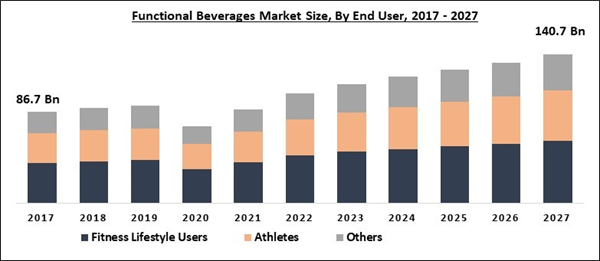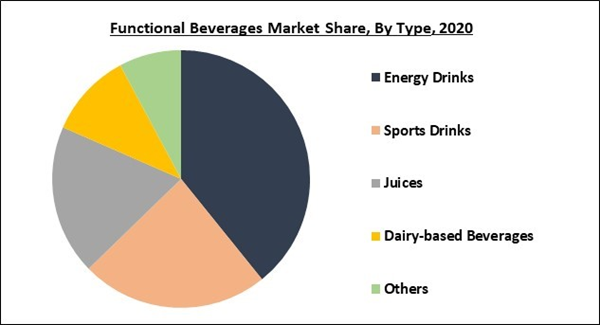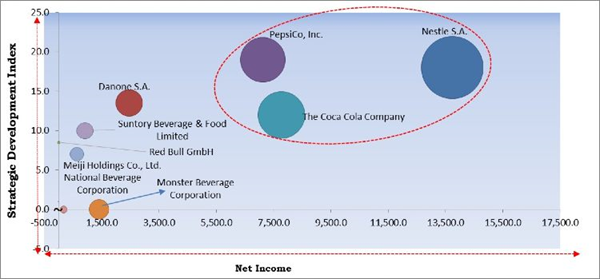The Global Functional Beverages Market size is expected to reach $140.7 billion by 2027, rising at a market growth of 8% CAGR during the forecast period. The presence of nontraditional ingredients such as minerals, probiotics, various artificial ingredients, and raw fruit are present in functional beverages makes them highly popular among the masses. These beverages offer nutritional value as well as health benefits and have positive effects on the mind & body.
The functional beverages market is witnessing considerable growth due to the shifting preferences of customers towards a healthy lifestyle and the growing number of fitness enthusiasts. In addition, people are participating in sports at international and national levels, leading to a rise in the number of athletes, thereby boosting the demand & growth of functional beverages in the global market. These beverages are excessively utilized to increase stamina and improve the mental alertness of the human body. In addition, customers are largely shifting from carbonated beverages to healthy beverages, which is expected to surge the demand for functional beverages and is expected to create new growth opportunities for the players operating in the global market.
Moreover, processing companies in this market are introducing beavers that contain low fat and calorie and adding vegetable & fruit flavoring additives to offer a unique taste to the rising number of casual users for sports and energy drinks. Casual users signify those customers who consume functional beverages just for fun and taste. Distribution channels have a significant role in the growth of the market. Distributional channels like hypermarkets, supermarkets, and specialty stores have high availability of functional beverages, thereby boosting the growth of the global market.
COVID-19 Impact Analysis
The outbreak of the COVID-19 has created a panic situation across the world and had a negative impact on several industries. During this pandemic, people started focusing on their health and have started consuming healthy beverages as well as foods. This led to fuel the demand for functional products as they help in boosting the immunity. Moreover, the effects of the coronavirus were mainly witnessed on the people having weak immune system. This is the major reason behind choosing functional foods and beverages as the integral part of the diet.
However, the functional beverages market witnessed a slow down during the COVID-19 as WHO announced it a public health emergency across the world. Several nations also witnessed lockdowns, which banned traveling and movements. Due to this, supply chains of functional drinks witnessed disruptions across the globe for a longer period, which has hampered the growth of the functional beverages market. Whereas, it is estimated that in the post-COVID period, the market will exhibit rapid growth, owing to increased demand from customers, innovation in the existing products, and increased awareness about these products.
Market Growth Factors:
Rapid growth in the organic, non-GMO, and clean-label products
The customer’s purchasing attitude is influenced by the growing number of organic, non-GMO, and clean-label products. This has resulted in changing the customer preferences from fruit juices and carbonated drinks to functional drinks, which is anticipated to surge the demand for such drinks over the forthcoming years. To fulfill the growing demand and offer an emotional appeal to the customer, the manufacturers are using natural, non-GMO, and clean label ingredients during the preparation time of functional beverages.
Growing awareness about health benefits offered by functional beverages
The objective of these beverages is to improve the body functionalities such as digestive health, weight management, immune system, and management of heart rate. In addition, these drinks contain amino acids, herbs, vitamins, and minerals. The presence of these nutritional components helps in reducing health issues due to which, customers are changing their preferences and inclining towards these functional drinks.
Market Restraining Factor:
High cost of functional drinks
The functional drinks are made from naturally sourced ingredients due to which, they are expensive in comparison to other drinks. For instance, dry beverage mixes offer high nutrients replacing the requirement of functional drinks, have low transportation costs, and are cost-effective. The manufacturing and commerce factors of functional drinks are very complicated, uncertain, and expensive.
End User Outlook
Based on End User, the market is segmented into Fitness Lifestyle Users, Athletes and Others. The fitness lifestyle users are a changing category of the health & fitness conscious category as customers have integrated fitness & sports activities into their daily life activities. In addition, the number of fitness lifestyle users is growing due to the rising awareness and health concerns about the benefits offered by yoga and daily exercise.
Type Outlook
Based on Type, the market is segmented into Energy Drinks, Sports Drinks, Juices, Dairy-based Beverages and Others. In 2020, the energy drinks segment dominated the functional beverages market and is expected to exhibit similar kind of trend even during forecasting years. Energy drinks offer physical & mental stimulation and instant energy. These drinks contain caffeine as a key ingredient, which offers stimuli to the body. In addition to this, they also contain taurine as one of the key ingredients that are important for the function and development of cardiovascular and skeletal muscle respectively.
Distribution Channel Outlook
Based on Distribution Channel, the market is segmented into Supermarket/Hypermarket, Specialty Stores, E-commerce and Others. Supermarkets & hypermarkets are focusing on increasing their product sales to improve their revenue share. Such stores also showcase a wide range of functional beverages products of varied brands. Further, the customers in regions like Europe and North America prefer supermarkets & hypermarkets for buying consumer goods. In the well-established and emerging region, the supermarkets & hypermarkets are gaining traction due to the growing working-class population and competitive prices, and rising urbanization.
Regional Outlook
Based on Regions, the market is segmented into North America, Europe, Asia Pacific, and Latin America, Middle East & Africa. North America holds the major revenue share of the market in 2020. The demand for dairy-based beverages and sports drinks is increasing in the market as these drinks help in improving stamina and performance of fitness lifestyle users & athletes. Moreover, the presence of key sports & energy functional beverages players such as Red Bull GmbH, Dr. Pepper Snapple Group Inc., and Monster Beverage Corp in this region is expected to further drive the market growth in the region. Thus, the aforementioned factors are accountable to accelerate the regional functional beverages market.
Cardinal Matrix - Functional Beverages Market Competition Analysis
The major strategies followed by the market participants are Product Launches. Based on the Analysis presented in the Cardinal matrix; PepsiCo, Inc., The Coca Cola Company and Nestle S.A. are the forerunners in the Functional Beverages Market. Companies such as Monster Beverage Corporation, Suntory Beverage & Food Limited, National Beverage Corporation are some of the key innovators in the market.
The market research report covers the analysis of key stake holders of the market. Key companies profiled in the report include PepsiCo, Inc., The Coca Cola Company, Nestle S.A., Danone S.A., Meiji Holdings Co., Ltd., Monster Beverage Corporation, Suntory Beverage & Food Limited, National Beverage Corporation, Red Bull GmbH, and Clif Bar & Company.
Recent Strategies Deployed in Functional Beverages Market
Partnerships, Collaborations and Agreements:
- Aug-2021: The Coca-Cola Beverages Africa (CCBA) partnered with Genpact, a global professional services firm focused on offering digital transformation. Under this partnership, CCBA is expected to focus on increasing its competitive growth. In addition, this partnership will leverage Genpact's deep process expertise to streamline CCBA's operations and integrate with digital technology & analytics to allow real-time business decision making.
- Jul-2021: Nestlé teamed up with Starbucks Corporation, an American multinational chain of coffeehouses and roastery reserves. This collaboration aimed to bring Starbucks Ready-to-Drink (RTD) coffee beverages to choose markets across Oceania, Latin America, and Southeast Asia.
- Oct-2020: Red Bull came into a partnership with JuiceInnov8, a food biotechnology company. Under this partnership, the companies focused on introducing three sugar-free and functional fruit juices. In comparison with conventional juices, these products is expected to contain 50% less sugar (less than 6g/100mL), calories (70-90kcal), and is expected to be known as Incredible Booost. Moreover, these products are promoted for immunity, cognitive health, and performance.
- Jan-2020: Nestlé signed an agreement with Merit Functional Foods and its technology partner Burcon NutraScience. This agreement is expected to commercialize and develop Merit’s innovative plant protein ingredients to be used in Nestlé’s plant-based foods & beverages.
Acquisitions and Mergers:
- Jul-2021: Nestlé Health Science acquired Nuun, a leader in functional hydration with a range of effervescent tablets and powders. This acquisition is expected to strengthen Nestle's other active lifestyle nutrition brands.
- Mar-2021: Nestlé took over Essentia Water, a functional water brand. Through this acquisition, the company aimed to transform its global water business.
- Jan-2021: PepsiCo formed a joint venture with Beyond Meat named The PLANeT Partnership. This joint venture aimed to leverage Beyond Meat's leading technology in plant-based protein development and PepsiCo's world-class marketing and commercial capabilities to develop and raise new snack & beverage options.
- Apr-2020: Meiji took over a 25% stake in AustAsia Investment Holding Pte that operates dairy farms in China. This acquisition is expected to enable the company to expand its dairy business across China.
- Mar-2020: PepsiCo took over Rockstar Energy Beverages, the popular energy drink maker. This acquisition aimed to allow Rockstar Energy to leverage PepsiCo’s capabilities to increase Rockstar's performance and unlock its capability to expand in the category along with existing brands like Mountain Dew.
Product Launches and Expansions:
- Aug-2021: Danone SA’s Evian brand launched Evian+, a new line of mineral enhanced sparkling beverages. Through this launch, the company aimed to help its customers via an afternoon slump.
- May-2021: Nestlé unveiled Wunda, a new pea-based beverage. The company focused on offering versatile and delicious pea-based beverages enriched with protein and fiber. In addition, this product is expected to provide a neutral taste and has the capability to utilize it for varied applications. Moreover, it is a perfect plant-based substitute for milk as it can neutral carbon.
- May-2021: PepsiCo introduced soulboost, a sparkling water beverage with a splash of real juice and functional ingredients. Soulboost integrates the fun of a fruity drink via light and guilt-free sparkling water refreshment, which is available in two varieties, Lift and Ease that provide four delicious flavors and just 10 to 20 calories per 12 oz can. In addition, the company has developed an innovative process, which enables it to both innovate and respond swiftly to the evolving preferences of customers.
- Mar-2021: Red Bull unveiled limited-edition Dragon Fruit flavor. Through this launch, the company aimed to expand its Red Bull Summer series, which also includes Beach Breeze, Coconut Berry, and Watermelon. This edition was inspired by the delicious and unique-looking exotic fruit called Pitaya or Dragon Fruit.
- Mar-2021: Red Bull introduced Red Bull Coconut Edition Sugarfree, providing the Wiiings of Red Bull Coconut Edition that is free from sugar. Through this launch, the company is expected to offer customers more variety and sugar-free products with an exclusive choice while working at the office or from home, studying, or juggling the daily needs of life.
- Jan-2021: The Coca-Cola unveiled Coca-Cola with Coffee in the US. This product is expected to offer a new refreshment coffee category to the fans of coca-cola and java lovers similar to a reinvigorating and refreshing start to their daily monotonous routine.
- Dec-2020: Danone released Aptamama, a probiotic product. This product helps in preventing lactation mastitis in breastfeeding mothers.
- Oct-2020: PepsiCo released Driftwell, a new functional beverage. This product helps customers to de-stress, relax, and unwind themselves as it contains magnesium, L-theanine, an amino acid mainly found in tea leaves, and has a spa-water-inspired flavor with hints of lavender & blackberry.
- Jul-2020: PepsiCo unveiled Naked Zing, a new sub-range of breakfast smoothies with a citrus twist. These smoothies are developed to provide a bolder start each day to the customers. This product is available in 750ml bottles with three flavors: Naked Strawberry Zing, Naked Tropical Zing, and Naked Mango Zing.
- Apr-2020: Nestlé released nesQino, a smart and simple solution. This product is expected to allow people to customize healthy superfood drinks that are made from 100% natural ingredients, in the office or at home. In addition, nesQino helps customers to make 21 different super food drink recipes designed by innovative nutritionists utilizing a variety of healthy ingredients.
- Apr-2020: Suntory released Black oolong tea and Lemon Plus, a new beverage approved under the food with function claim (FFC) scheme. These products help in restraining the post-meal absorption of carbohydrates, especially sugar.
Geographical Expansions:
- May-2020: Red Bull expanded its geographical reach in China by investing USD 150 million in operations across the nation. The company through this expansion is expected to increase its presence in the Chinese market by supporting its in-country team, its local partnerships, manufacturing centers, the introduction of new Red Bull products & other innovative products from TCP's global portfolio, and setting up a new representative office.
Scope of the Study
Market Segments Covered in the Report:
By End User
- Fitness Lifestyle Users
- Athletes
- Others
By Type
- Energy Drinks
- Sports Drinks
- Juices
- Dairy-based Beverages
- Others
By Distribution Channel
- Supermarket/Hypermarket
- Specialty Stores
- E-commerce
- Others
By Geography
- North America
- US
- Canada
- Mexico
- Rest of North America
- Europe
- Germany
- UK
- France
- Russia
- Spain
- Italy
- Rest of Europe
- Asia Pacific
- China
- Japan
- India
- South Korea
- Singapore
- Malaysia
- Rest of Asia Pacific
- LAMEA
- Brazil
- Argentina
- UAE
- Saudi Arabia
- South Africa
- Nigeria
- Rest of LAMEA
Key Market Players
List of Companies Profiled in the Report:
- PepsiCo, Inc.
- The Coca Cola Company
- Nestle S.A.
- Danone S.A.
- Meiji Holdings Co., Ltd.
- Monster Beverage Corporation
- Suntory Beverage & Food Limited
- National Beverage Corporation
- Red Bull GmbH
- Clif Bar & Company
Unique Offerings from the Publisher
- Exhaustive coverage
- The highest number of market tables and figures
- Subscription-based model available
- Guaranteed best price
- Assured post sales research support with 10% customization free
Table of Contents
Companies Mentioned
- PepsiCo, Inc.
- The Coca Cola Company
- Nestle S.A.
- Danone S.A.
- Meiji Holdings Co., Ltd.
- Monster Beverage Corporation
- Suntory Beverage & Food Limited
- National Beverage Corporation
- Red Bull GmbH
- Clif Bar & Company
Methodology

LOADING...











